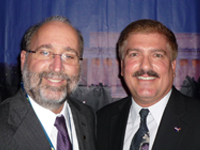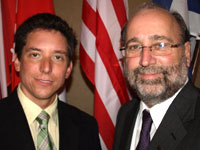GLOBE News
Community Spotlight: John Moore and Todd Toth

8/01/2011 10:00 MDT - John Moore and Todd Toth are GLOBE educators and friends who had the pleasure of reuniting in Washington DC recently at the 15th GLOBE Annual Partner Meeting. John and Todd hold the distinction of having been among the original 25 participants selected for the very first GLOBE teacher training in 1995, held at West Chester University in Pennsylvania, USA. The two teachers shared a sense of excitement that they were experiencing the cutting edge in hands-on science and education training. They became thoroughly immersed in GLOBE and went to work immediately to implement the program in their respective schools.
"The rest is history," says Todd, whose enthusiasm for GLOBE resulted in a new course for his Waynesboro Senior High School students in Waynesboro, Pennsylvania, called Environmental Research, based entirely on GLOBE protocols. Students and their parents were told from day one they would be doing research outdoors: in the pond, streams and fields near the school, year round in rain or snow. They collected data, analyzed it, and sent it to the GLOBE database. They also used the data in their own student research. The course functioned so well that a local university accredited the course and Todd's students, who achieved a grade of A or B, were able to receive 3 college credits.
John had come to the training as a seasoned Space Science educator; he had already helped to establish an annual Satellite and Education Conference at West Chester University. After participating in the GLOBE training, he returned to the Burlington County Institute of Technology, a technical high school in Medford, New Jersey, to begin ground-truthing remotely sensed satellite data of atmospheric scientists with GLOBE student data. Collaboration between GLOBE students and scientists is a unique feature of the GLOBE program. "I feel the GLOBE Program continues to provide an infrastructure where teachers and students from around the world have an opportunity to collaborate in projects of interest. As a teacher, I felt it extremely important to have my students learn and follow scientific protocols and often having the opportunity to interact with scientists. I was able conduct joint GLOBE projects that allowed me to take students to Finland, Demark, and Croatia, and to have students present at scientific meetings in Canada, France, and Alaska in the USA."
From their initial introduction to GLOBE in 1995 until today, both men recognize the role that GLOBE has played in their flourishing professional careers. John Moore is about to come to the end of his 2-year tenure as an Albert Einstein Distinguished Educator Fellow. Einstein Fellows are Master STEM education teachers invited to Washington to work in various Federal Agencies including the U.S. Department of Education, the U.S. Department of Energy, NASA, NOAA, and the National Science Foundation. The Fellows provide their educational expertise, years of experience and personal insights to contribute to an understanding of the value of STEM education. John's Fellowship came as a crowning achievement after 28 years of dedicated service as a teacher. His Sponsor has been Dr. Jill Karsten, Director for Diversity and Education at the Directorate for Geosciences of the National Science Foundation. John has been working with the multitude of programs that "GEO" funds, including the GLOBE Program. Throughout his Fellowship he has had frequent opportunities to attend and present on topics that relate to K-12 education, STEM Education, and /or the related Geosciences in Washington and at various scientific and educational conferences around the world. "GLOBE has a perfect opportunity to impact the STEM Education discussion here in the USA," writes John. He also believes that Career and Technical Education (CTE) can and will play a role in providing opportunities and model programs for students to be exposed to, and practice Science, Technology, Engineering, and Mathematics (STEM) through Project Based Learning. "Research is indicating that field experiences and participation in practical hands-on applications of science, is the best way to peak students' interests. This was certainly the case for

one of my students, Peter Dorofy (pictured above on left), whose interest in science and the satellite and remote sensing applications in the Environmental Sciences helped shape his career path. As a student, Pete graduated before the GLOBE Program was established, but as a teacher of Earth Sciences and Physics, he quickly adopted the GLOBE Program as part of his curriculum. When I accepted the Einstein Fellowship, there was no better choice to take over the program then Pete." John Moore currently coordinates GLOBE activities at the Palmyra Cove Nature Park in New Jersey. Peter Dorofy works alongside him in developing new projects and programs that together they carry out as part of their GLOBE Partnership strategic plan.
Todd Toth, who taught high school classes in Earth and Space Science as well as Environmental Research for 32 years, is currently employed at NASA's Goddard Space Flight Center in Greenbelt, Maryland. There he serves as liaison between the Office of Education and the Astrophysics, Heliophysics and Planetary Divisions. In 2009 he became the Office of Education liaison to the James Webb Space Telescope (JWST) Mission, a large, infrared-optimized space telescope that is scheduled to launch in 2018. This telescope will have a large mirror, 6.5 meters (21.3 feet) in diameter and a sunshield the size of a tennis court. Its mission is to find the first galaxies that formed in the early Universe. In this capacity, Todd is learning about the telescope and the people working on the specific parts or pieces of scientific equipment that will make up the telescope. He works closely with the Space Telescope Science Institute in Baltimore, Maryland that is developing and distributing all educational materials associated with the James Webb Space Telescope. It was The GLOBE program that opened doors that led to Todd's current position at NASA. "Meeting and working with NOAA scientists through GLOBE allowed me to be one of NOAA's Teachers in the Air. Flying in a high altitude jet (NOAA's G-1V jet aircraft, also known as "Gonzo"), taking atmospheric readings and learning how scientists acquire their data was unbelievably neat. Also, becoming a Skywarn spotter for the National Weather Service. You just don't know where GLOBE involvement will take you."
John Moore agrees. "As my Fellowship ends in Washington, my work continues in new and exciting ways. Another Fellow, Kevin Simmons and I have created a new enterprise that utilizes CubeSats called BLUECUBE. Teachers and students in the K-12 community will have the opportunity to use BLUECUBE to Build, Launch, Utilize, and Educate using remotely sensed data and imagery. The Space-Earth theme "Observing our Earth from Space" continues in new and exciting ways that will prepare and inspire our next generation of geoscientists and STEM educators. As GLOBE teachers and students from around the world continue to build on a 16-year mission of Global Learning and Observations to Benefit the Environment, we can know that the future of our planet is in good hands."
****
Please note:
Many GLOBE teachers would make excellent candidates for the Albert Einstein Distinguished Educator Fellowship. Information about the Fellowship can be found online.
type: globe-newsNews origin: GLOBE Implementation Office





